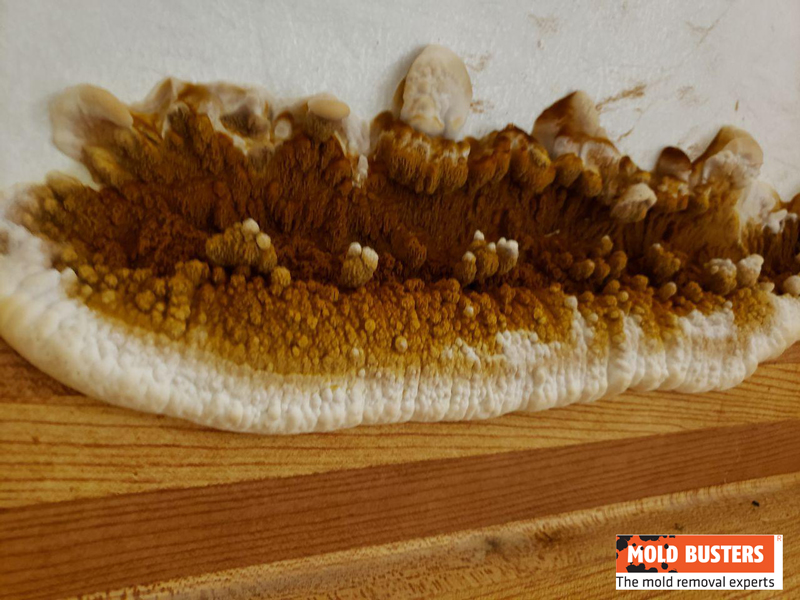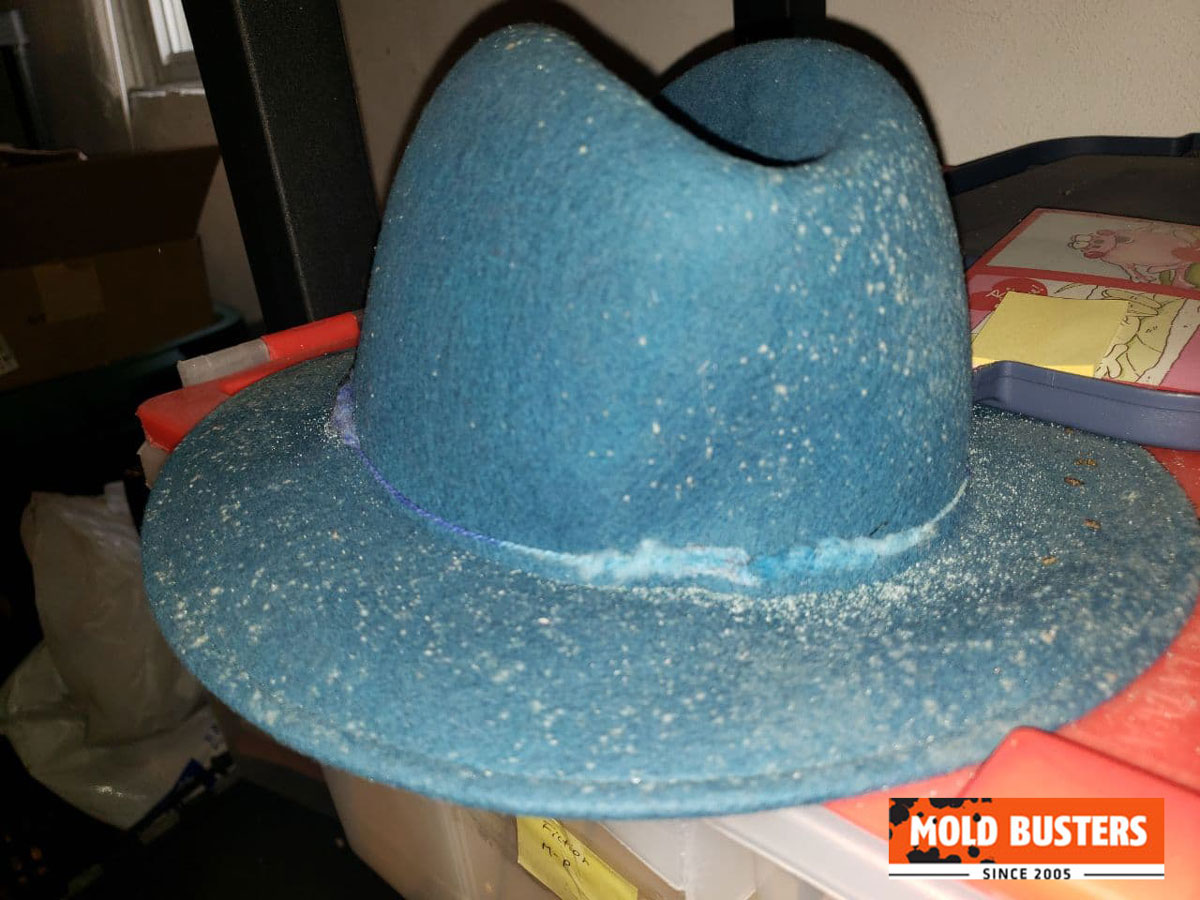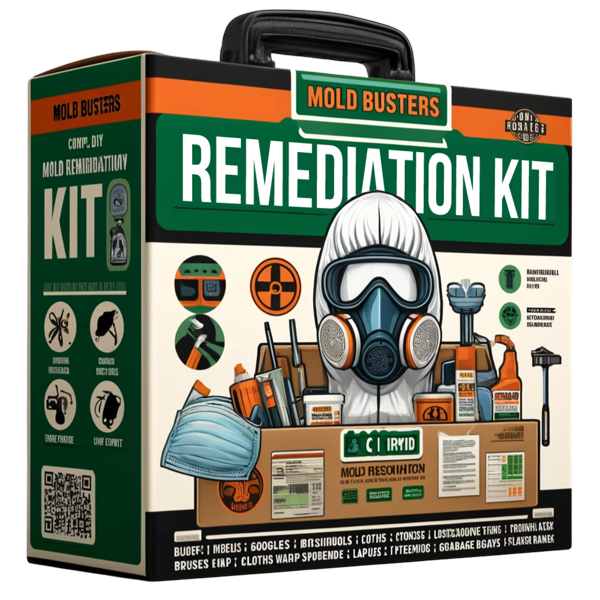What Is Yellow Mold and How to Identify & Remove Yellow Mold
Did you know that there are thousands of species of mold? Unless you’re a certified expert offering mold removal and testing services, it can be hard to familiarize yourself with them all. Fortunately, you’re in the right place! When it comes to yellow mold, we have a lot of critical information to share.
Mold comes in many colours and thousands of species. If you’ve encountered yellow mold, you may wonder: What does the colour tell me? What makes it different from other molds? Is it safe for me to get rid of or do I need to call in an expert?
Get Your Free Mold Inspection Today!
Yellow mold can be dangerous and tricky to deal with. If you’ve noticed yellow patches or suspect mold in your home, don’t wait until it’s too late! Contact Mold Busters today for a free virtual mold inspection. Our certified inspectors will assess your situation and provide a comprehensive plan to eliminate mold from your property. Remember, addressing mold issues promptly is crucial for your health and safety.
What is yellow mold?
Like all mold, yellow mold is a type of fungus. As a living organism, it feeds on a combination of moisture, oxygen and organic matter—all of which can be found in your home.
Of the thousands of species of mold, many of them can take on a yellow appearance, so keep an eye out and know to suspect mold if you see a yellowish coating on household surfaces, especially where it’s damp.
What isn’t yellow mold?
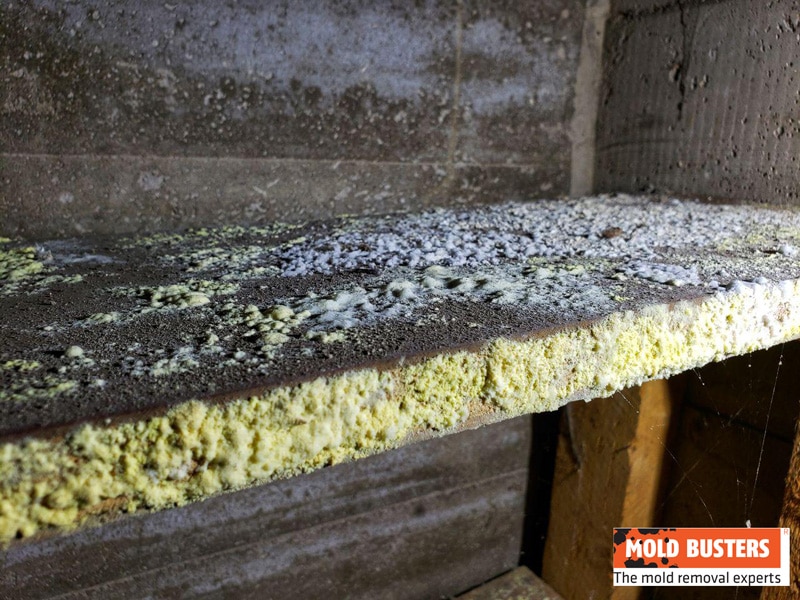
Pollen is probably the most common substance that gets confused with mold. While patches of yellow on household surfaces may well be mold, in some cases it is simply pollen.
Pollen is a powder produced by plants as they germinate. It gets carried in the air, often from the outside, and might collect near windows, or perhaps around flowers in your house that have shed the pollen.
What does yellow mold look like?
Various species of mold can take on a yellow colour. Exact hue and appearance can vary widely depending on the type of mold involved, from intensely yellow to a more muted appearance.
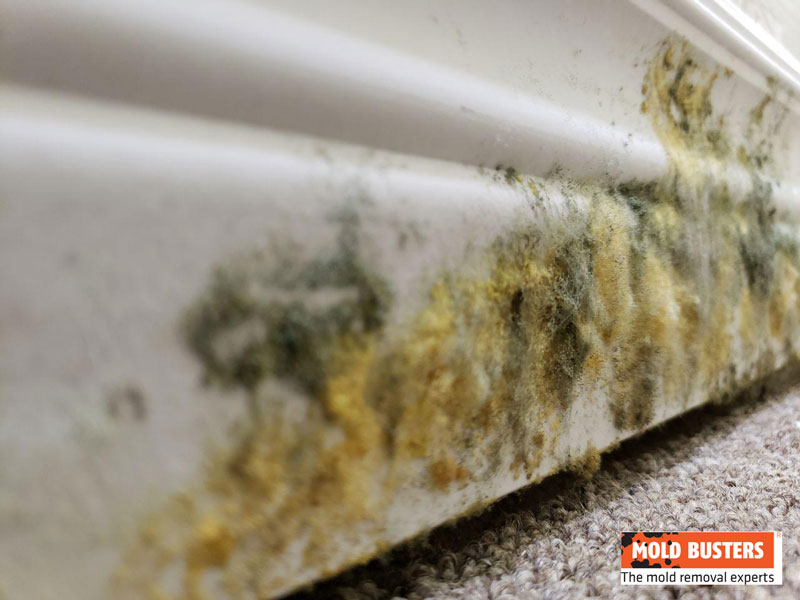
Some yellow mold may appear as patches of dusty or fuzzy yellow, while a common type of mold with a yellow colouration is known as “slime mold” which has a gelatinous texture.
What is yellow slime mold?
There are over 900 species that can be called “slime mold”. They can be various colours, but yellow is one of the more common colours for slime mold. Unlike other types of mold, slime molds are single-celled organisms that are not technically fungi. Lacking the tissue structure of multi-cellular molds, slime molds have a soft, liquid texture.
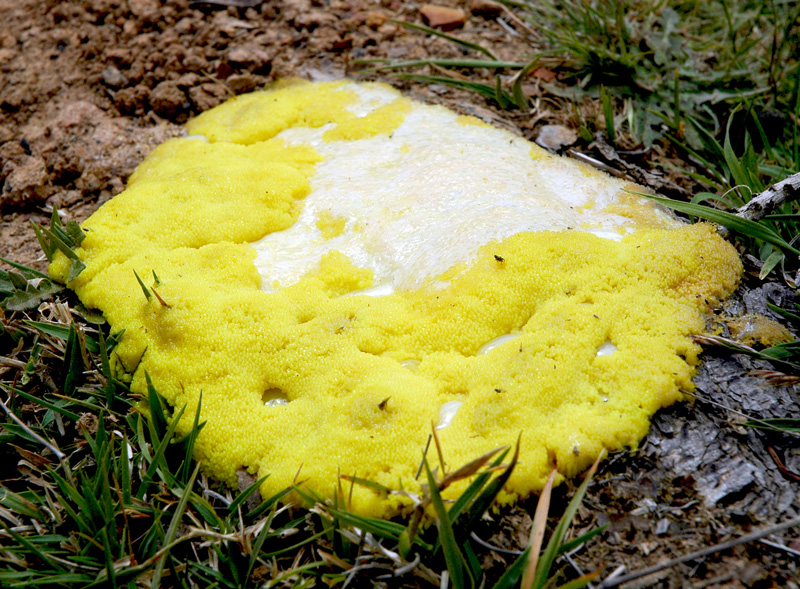
Slime molds feed off of decomposing plant matter and are commonly found in soil and on the forest floor. Around the home, you may find slime mold in the mulch on your lawn, among leaves collecting in your eaves troughs, or inside in an air conditioner unit—particularly if its drainage is clogged and it’s collecting water.
What other types of mold are yellow?
Besides slime mold, many other types of yellow mold can be found around the home:
- Aspergillus is a very common genus of mold, with several strains that can take on a yellow appearance. Several of these species can trigger allergies, respiratory disease or generate poisonous mycotoxins.
- Mucor is a fast-growing mold that goes through a yellow phase as it matures, eventually turning grey. It is particularly dangerous as it can infect internal organs such as the sinuses, lungs or even the brain, causing a disease known as mucormycosis.
- Serpula lacrymans is a species of mold that can grow rapidly on wood and cause dry rot. For this reason it is also known as “house eating mold”.
Serpula lacrymans - Epicoccum nigrum can be yellow, orange or brown. It has the ability to grow on a wide variety of household surfaces, from wood to drywall, in carpets and mattresses, and even on painted surfaces.
- Cladosporium is another common genus of mold that can appear yellow during a growth phase though it mostly presents as white mold. Fortunately, when it’s in its yellow phase it may still be on the surface and easier to clean.
- Geomyces pannorum is a mold common in the northern hemisphere that has the unusual feature of preferring colder climates, where most other molds prefer warmer temperatures. It can be found on various household surfaces including wood, walls, flooring and even paper.
For more see the types of mold in our resource library.

Did you know?
Cladosporium is the 2nd common mold type found in homes we tested?! Find out more exciting mold stats and facts inside our mold statistics page.
What causes yellow mold?
Like other kinds of mold, yellow mold spreads by releasing spores into the air. These spores can then start new mold colonies anywhere they find these key ingredients:
- Moisture
- Organic matter to feed on
- The right temperature
Depending on the particular species of mold, warmer or cooler parts of your home may provide the ideal environment for a yellow mold infestation to take root. For more information on this topic, see our article on Causes of Mold.
Pictures of yellow mold
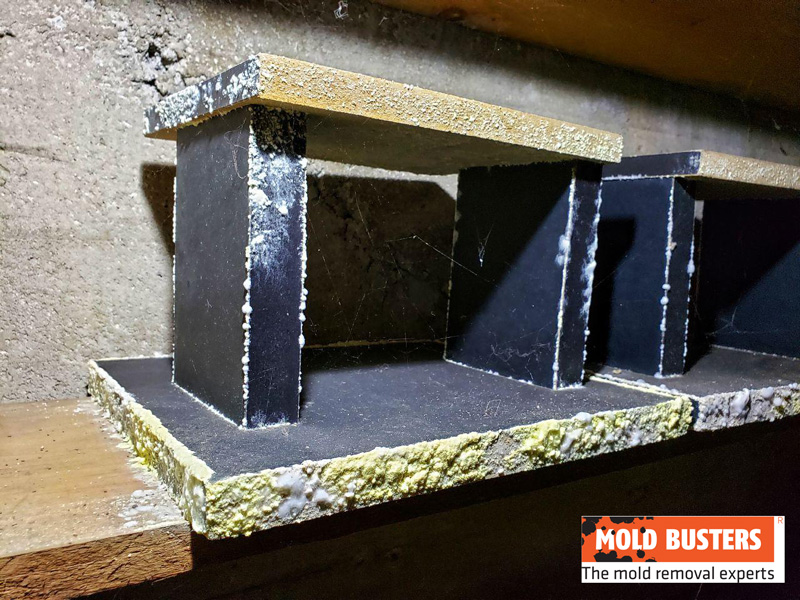
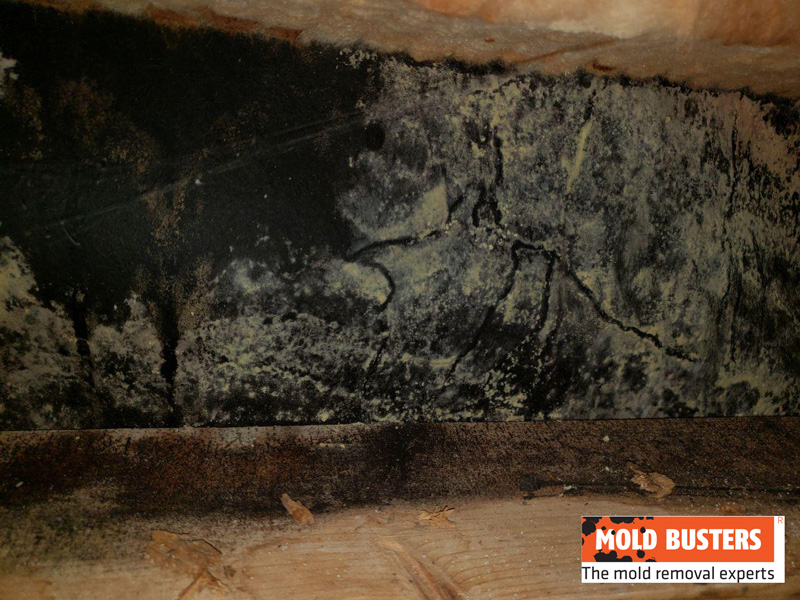
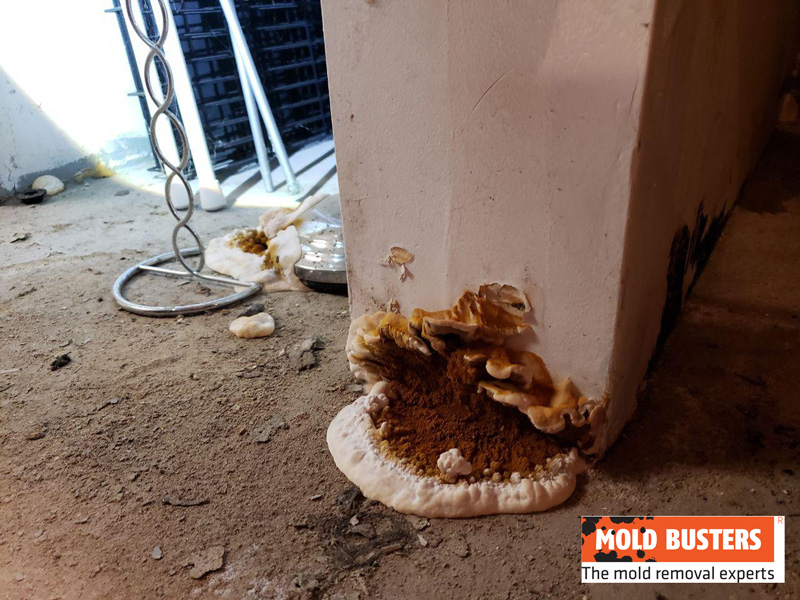
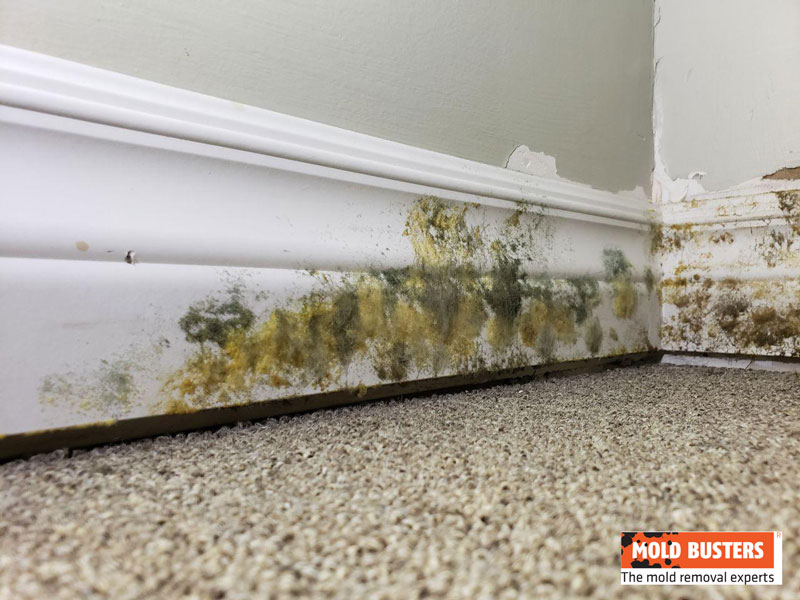
Where can you find yellow mold in house?
Unlike plants, mold does not depend on sunlight to live. It often thrives in dark and humid spaces, including dark, damp areas of the house: your basement, your bathroom, your kitchen, even in walls and attics especially if there’s a leak or water damage.
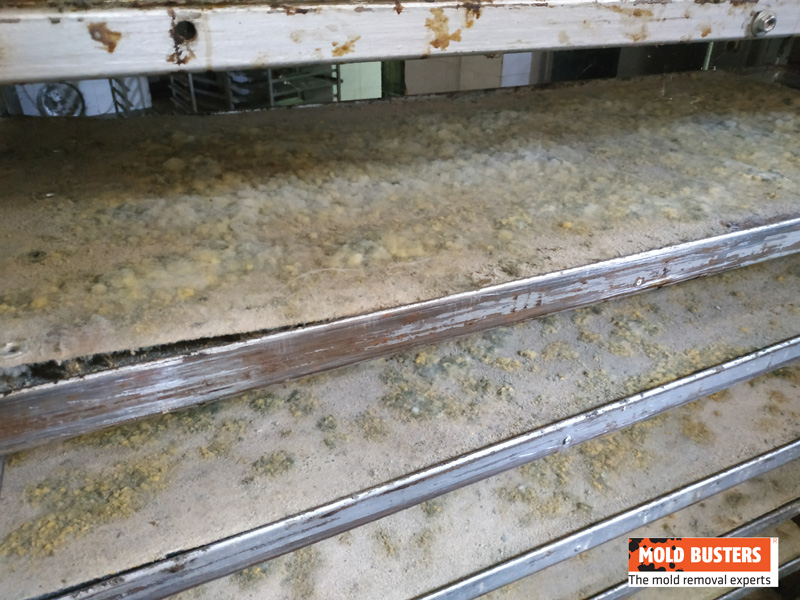
As explained above, many types of yellow mold can thrive on various household surfaces: some favour wood while others can live in drywall, carpets, mattresses, fabric, in air conditioners or almost anywhere in the house where moisture can be found. See below for some examples, and also check out our article Where to Look for Mold.
Yellow mold on food (bread)
Yellow mold, particularly strains of Aspergillus, can be found on food, especially bread. The moisture and nutrients in bread provide an ideal breeding ground for mold.
Storing bread at room temperature offers an ideal climate for mold to develop. Learn more about yellow mold on food in our article What Happens If You Eat Mold?
Yellow Spots on Bagel
Noticing yellow spots on your bagel? This could be a sign of yellow mold growth. Consuming moldy food can lead to mold exposure and potential health issues. Mold thrives in environments where there’s moisture and food, making bagels a perfect host. It’s recommended to discard any food items that show signs of mold to prevent mold related health problems. Always store your bagels in a dry place and consume them before their expiration date.
Yellow mold outside the house
Several types of mold favour decaying plant material to feed on. They often prefer cooler, shadier places. As such, these types of yellow mold might be found in the mulch or topsoil of your lawn or garden, on the underside of plants or in among the roots, or feeding off leaves that have collected in your eaves trough.
Yellow mold on wood
Wood is another common source of nutrients for some types of yellow mold, from the aptly named—and disgusting — dog’s vomit slime mold, to the “home eating” yellow mold that causes dry rot.
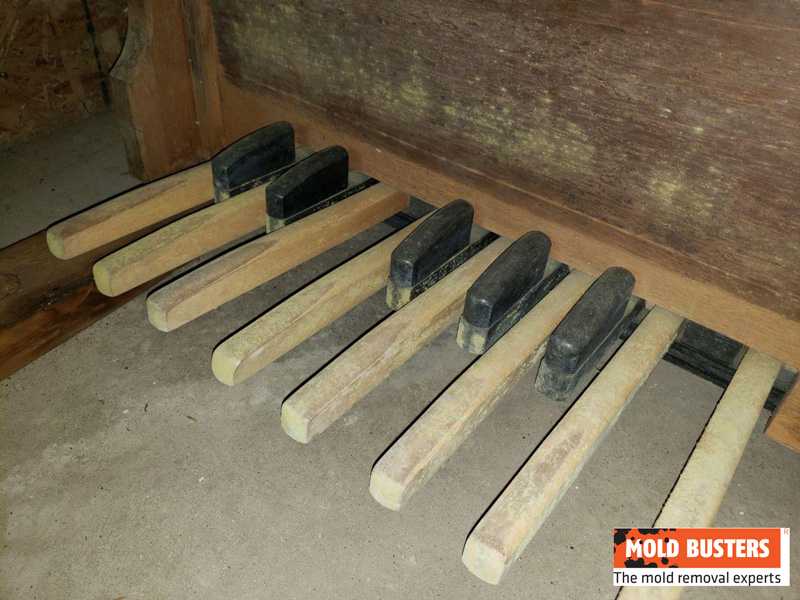
No matter the species, you don’t want these molds feeding on the wood of your house. As with any mold, if you find it in your home, you’ll want to promptly eradicate the infestation.
Yellow mold in the bathroom
Bathrooms are constantly exposed to different forms of moisture (steam, water, etc.) and, as such, are damp at the best of times. When a leak is involved, there is extra danger of mold developing.
Among mold species, Aspergillus is particularly known for taking root where there is water damage. If you are faced with a mold problem in the bathroom, see our page on Bathroom Mold Removal.
Yellow mold in the basement
Dark, humid basements provide an ideal environment for mold to take root. Exposed joists or beams of an unfinished basement can provide a base for “house eating mold” to set in, causing dry rot that can threaten the whole structure of your house.
Other forms of yellow mold can also form in the carpeting, drywall and the fabric of furniture kept in a finished basement.
Yellow mold in a crawl space
While crawl spaces should normally be dry, if humid air or a leak are present, then moisture in a crawl space can combine with the temperature and shade to form ideal circumstances for a mold infestation.
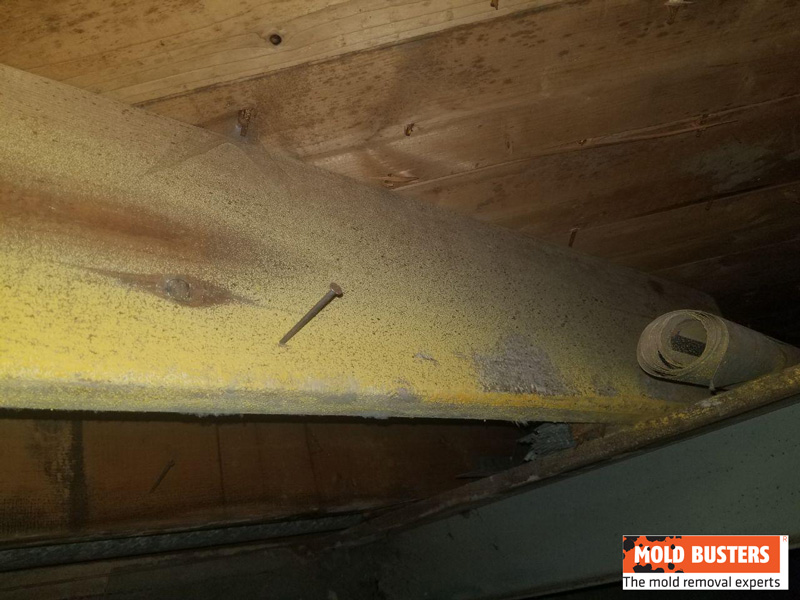
Often, wood or just dust accumulating in crawl spaces provide enough nutrients for yellow mold to thrive.
Yellow Mold on Clothes
Yellow mold on clothes is often a result of prolonged dampness and lack of ventilation. This type of mold growth can lead to mold related illness if not addressed promptly. Clothes, especially those stored in damp areas, can become a breeding ground for yellow mold spores. It’s essential to initiate mold removal as soon as you’ve discovered yellow mold on your garments. Washing the clothes in warm water and ensuring they dry completely can help in eliminating the mold.
Yellow Mold on Baseboards
Baseboards in homes can often become a breeding ground for yellow molds, especially if there’s moisture. Household mold, especially the very common household mold like the yellow variety, can grow on wooden structures, including baseboards. Over time, this mold can deteriorate the wood and affect the indoor air quality. Regular cleaning and testing mold presence can help in early detection and prevention. Ensure your home is well-ventilated and dry to prevent mold growth on baseboards.
Yellow Mold on Brick
Bricks, especially in damp areas, can show signs of yellow mold growth. This mold can deteriorate the quality of the bricks and lead to structural issues. Bricks in basements or shaded areas of the home are particularly susceptible. Regular inspection and cleaning with a mold removal solution can help in keeping the bricks mold-free. Ensure that the surrounding areas are dry and well-ventilated to prevent mold growth.
Yellow Mold in Plant Soil
Yellow mold growing in plant soil indicates overwatering or poor drainage. This mold can affect the plant’s health and also release yellow mold spores into the environment, leading to potential mold exposure. Overwatered plants or those in containers without proper drainage are especially at risk. It’s crucial to maintain the right moisture levels for plants and ensure proper drainage to prevent mold growth. Regularly check the soil and adjust your watering schedule accordingly.
Yellow Mold on Carpet
Carpets can trap moisture, making them susceptible to yellow mold growth. Regular cleaning and ensuring the carpet is dry can help in preventing mold. Carpets in basements or areas prone to moisture should be checked regularly. If you discover mold, consider professional mold removal services. Using dehumidifiers and ensuring proper ventilation can also help in reducing the risk of mold growth on carpets.
Yellow Mold on Ceiling
Ceilings, especially those near leaky sinks or leaky windows, can show signs of yellow mold. This mold can lead to respiratory issues and other health problems. Ceilings in bathrooms or kitchens, where there’s a lot of moisture, are especially at risk. Regular inspection and cleaning are essential to keep ceilings mold-free. Ensure that any leaks or sources of moisture are promptly addressed to prevent mold growth.
Yellow Dust in House
Yellow dust in the house might be a sign of yellow mold spores spreading. This can lead to mold related illness and other respiratory issues. Dust can accumulate in areas with poor ventilation or where there’s a lot of moisture. Ensure to clean the dust regularly and check for potential mold growth sources in the house. Using air purifiers and ensuring regular cleaning can help in reducing the spread of yellow mold spores.
Remember, whenever dealing with mold, especially the rapidly growing strain, it’s essential to wear protective gear to prevent any health issues. Mold can lead to severe health problems, especially for those with compromised immune systems. Always follow strict safety precautions and consult with professionals when in doubt.
Health risks of yellow mold
As with all mold, various strains of yellow mold can be hazardous to your health. You or your family may experience allergic reactions, illness or you may even be poisoned by toxins created by certain types of mold.
For general information on health risks of mold, see our article on Health Effects of Mold. But for some specific examples of concerns linked to yellow mold in particular, read on…
Is yellow mold dangerous and toxic?
Some species of yellow mold produce poisons called mycotoxins. These poisons can enter the body through breathing in spores from yellow mold in the home, through the skin by touching yellow mold, or otherwise ingesting the toxin. There are many types of mycotoxin, and illnesses resulting from mycotoxin poisoning can vary from acute to chronic, mild to severe.
You might be familiar with “toxic black mold” that is notorious for producing these harmful mycotoxins, but some yellow mold can produce it too. Therefore, if you find yellow mold in your household, it’s important to eradicate it right away.
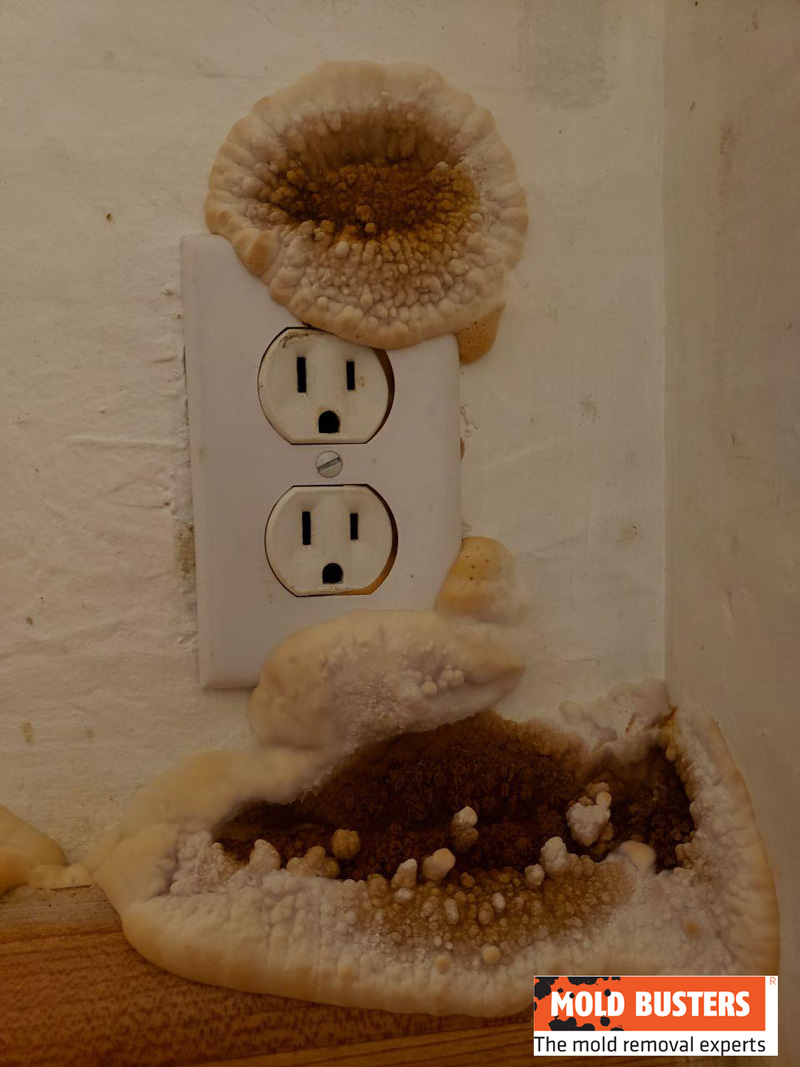
Can yellow mold make you sick?
In addition to the general health risks of all molds, there are some specific risks associated with specific types of yellow mold:
- As noted above, mucor causes mucormycosis, an infection that most commonly infects the oral cavity or brain, but can also affect your gut, skin, or other internal organs. Infections lead to tissue damage and tissue death, producing symptoms that vary depending on where the infection has taken root: one-sided headaches, fever, eye swelling, coughing and difficulty breathing, abdominal pain, nausea, vomiting. In extreme cases, mucormycosis can even lead to death.
- Various strains of Aspergillus, a genus of mold that can sometimes appear yellow, are the most common source of severe pulmonary allergic reaction, and can lead to asthma, other respiratory problems, and damage to the lungs.
- Serpula lacrymans or “house eating mold” can, in addition to harming the wood structures holding up your house, be harmful to your health by causing respiratory problems such as coughing, sneezing, sore throat, etc.
How to identify yellow mold?
You may have yellow mold in your house and not be able to see it. This may be because the mold is growing in an inaccessible area or hasn’t developed to the point of being visible yet. Early signs of mold include a musty smell and allergic reactions.
If you can see yellow patches in your home, it might be yellow mold. Depending on the species, the appearance can vary from bright yellow to muted, from powdery to slimy. Visual cues can also be indirect: cracking or bubbling paint or wallpaper could be a sign of mold growing underneath.
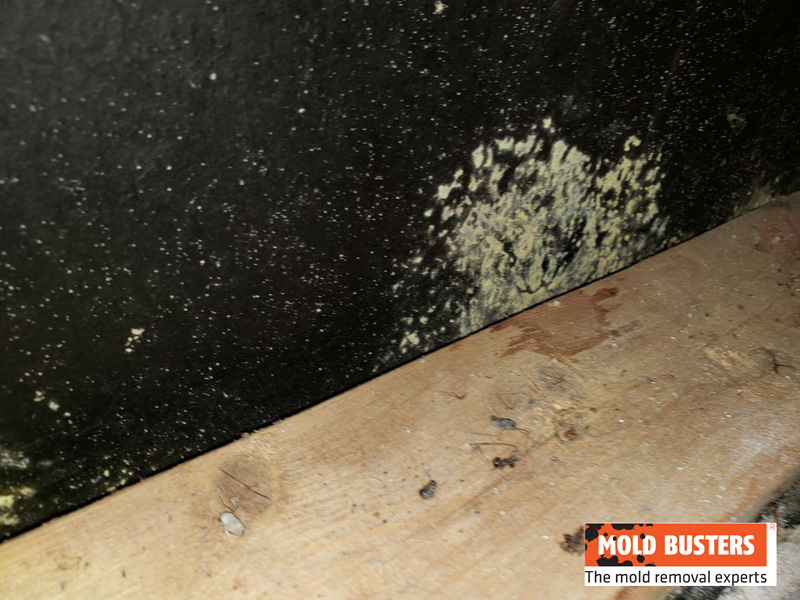
Whether you’ve spotted what looks to be mold, or you suspect mold because of smell, allergies or other signs, the best way to be certain that what you’re dealing with is mold is to bring in an expert. At Mold Busters, we offer services like virtual inspection to help you identify and deal with mold issues effectively.
Check out our page on Mold Testing to learn more about the benefits of having your home tested for mold.
Is it yellow mold or pollen?
As mentioned above, yellow mold can be mistaken for pollen or vice versa. If you encounter a yellow substance in your home and aren’t sure if it’s pollen or mold, consider:
- Mold thrives on moisture and organic matter; pollen can end up anywhere the breeze takes it.
- Pollen often has a sweet smell; mold has a characteristic musty smell.
- Most species of mold prefer shady spaces.
If you’re uncertain whether a yellow substance in your home is mold or pollen, it never hurts to bring in an inspector to safely determine whether you have a mold infestation or not.
How to get rid of yellow mold?
If you have yellow mold in your home, you might be asking yourself: can I get rid of this myself? This is rarely a good idea. Before you consider tackling a mold problem yourself, consider:
- The mold may be present well beyond what’s visible (inside walls, under carpets, in air ducts and other inaccessible spaces, etc.).
- Getting rid of the immediate presence of mold doesn’t address the cause of mold developing in the first place (water leakage, chronic dampness or humidity, etc.).
- The act of removing the mold can expose you to harmful allergens and poisonous mycotoxins by breathing in mold spores or exposure through your skin.
- Touching the mold can actually contribute to spreading mold spores throughout the house, causing mold infestation elsewhere.
For these reasons, we strongly recommend your first line of defense be to bring in mold remediation experts. See our section on Mold Removal for help. Our teams in Montreal and Ottawa are always ready to assist you with your mold problems.
Tackle Yellow Mold with Our DIY Remediation Kit!
Worried about yellow mold in your home? Our DIY Mold Remediation Kit has everything you need to safely and effectively remove mold. The kit includes protective gear, eco-friendly cleaning products, and an easy-to-follow manual.
How to prevent yellow mold in the home?
While removing yellow mold is best left to the experts, there are many steps you can take to prevent it from taking hold in your home in the first place. Since mold depends on moisture to thrive, much of the work in preventing mold is in controlling water and humidity in your home, particularly in the bathroom, kitchen, basement and elsewhere that moisture may be present.
Mold Busters is proud to offer How to Prevent Mold: The Ultimate Guide, offering expert advice through five chapters on how to prevent mold infestations in your home.
Conclusion
Whatever the colour, no mold is good mold. Certain species of yellow mold present particular risks, but the main thing to remember about mold is: it never belongs in your house. If you experience signs of mold in your house, whether by sight, smell or signs of allergies or illness, you don’t need to worry about identifying it. You don’t need to know if it’s house-eating Serpula lacrymans, allergy-provoking and possibly toxic Aspergillus, or infectious and potentially deadly Mucor. Just get rid of it.
Don’t be a hero: if you have—or even suspect—a mold problem in your house, bring in experts to identify and eradicate the mold safely and effectively. In the meantime, take steps to keep your home and household items dry and mold-free so you never get to the point of asking yourself if a particular colour of mold is hazardous or toxic.

Get Special Gift: Industry-Standard Mold Removal Guidelines
Download the industry-standard guidelines that Mold Busters use in their own mold removal services, including news, tips and special offers:
Published: July 15, 2019 Updated: April 10, 2020

Written by:
John Ward
Account Executive
Mold Busters
Fact checked by:
Michael Golubev
CEO
Mold Busters

